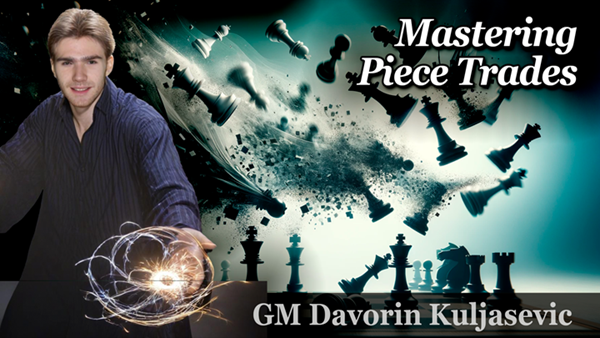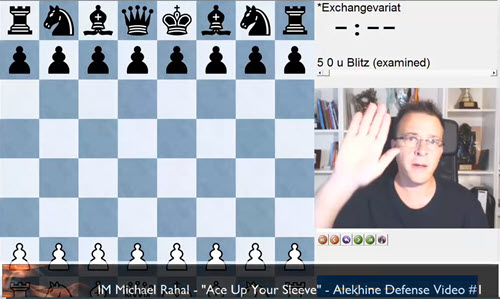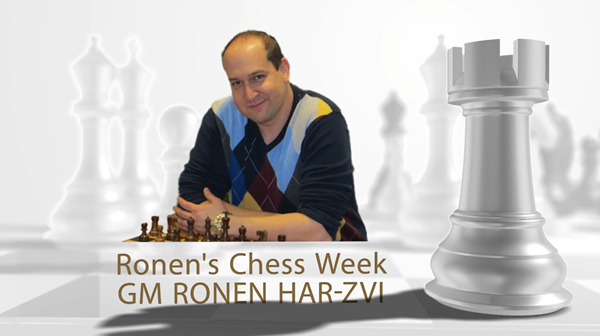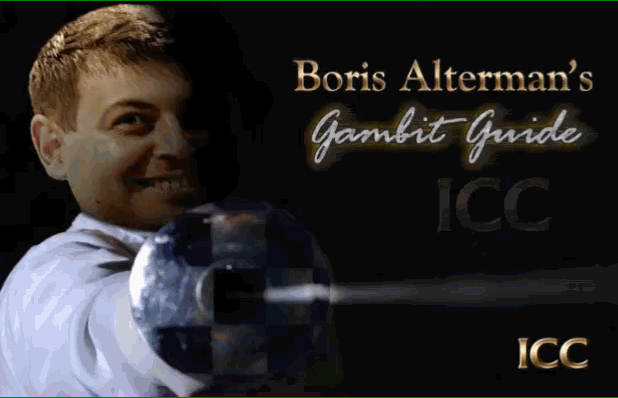Opening: D53, E41, B22:
Player(s): Yermolinsky, Donaldson, Kaufman, Doyle
Exchange sacrifice is a powerful tool that has many uses in different stages of the game. Pertaining to the endgame it's most often used to stifle the opponent's initiative and maybe viewed primarily as a defensive resource. However, in many cases it also allows to fight for an advantage. How can a less effective piece compete against a more powerful one? Obviously, some other factors need to be present. It begins with a pawn advantage, both quantitative and qualitative. Usually, at least one extra pawn is required to provide adequate compensation, and you'd probably need at least two extra pawns to play for a win. Your pawn structure is better be solid to withstand attacks from enemy rook(s). It is important to keep the base of your pawn chain safely protected. Another factor is the presence of other pieces. The advantage of Rook vs minor piece is most visible in its pure form, so when considering a sacrifice you need to make sure you'll be able to keep your last rook on the board.
This material configuration has occurred in a number of games, and more examples are given in Videos #2 and #3. From the point of view of the defender a return exchange sac must be considered as a last-ditch attempt to save the game. The consequences of a transition into a rook endgame must be carefully analyzed.
Teacher's library (718) D53 E41 B22 Yermolinsky Donaldson Kaufman Doyle endgame
This is a 5 minute preview.
Log in to watch the full show or click one of the links below.
Page 1 of 91 pages 1 2 3 > Last ›

Added on 04.26.2024
GM Miguel Illescas - Top 10 Checkmate Patterns - Part 4

Added on 04.24.2024
GM Davorin Kuljasevic - Mastering Piece Trades - Video 10

Added on 04.22.2024
B00 IM Rahal Ace up Your Sleeve - Nimzowitsch Defense - Part 1

Added on 04.19.2024
E46, A09 GM Miguel Illescas - Top 10 Checkmate Patterns - Part 3

Added on 04.17.2024
GM Davorin Kuljasevic - Mastering Piece Trades - Video 9

Added on 04.15.2024
C00 IM Rahal Ace up Your Sleeve - French Wing Gambit - Part 2

Added on 04.12.2024
GM Miguel Illescas - Top 10 Checkmate Patterns - Part 2

Added on 04.10.2024
GM Davorin Kuljasevic - Mastering Piece Trades - Video 8

Added on 04.08.2024
C00 IM Rahal Ace up Your Sleeve - French Wing Gambit - Part 1

Added on 04.05.2024
A80, A00, C20 GM Miguel Illescas - Top 10 Checkmate Patterns - Part 1

Added on 04.03.2024
GM Davorin Kuljasevic - Mastering Piece Trades - Video 7

Added on 04.01.2024
B03 IM Rahal Ace up Your Sleeve - Alekhine Exchange Variation - Part 2

Added on 03.29.2024
A21 GM Alex Yermolinsky - The Timman-Anand Variation - Part 5

Added on 03.27.2024
GM Davorin Kuljasevic - Mastering Piece Trades - Video 6

Added on 03.25.2024
B03 IM Rahal Ace up Your Sleeve - Alekhine Exchange Variation - Part 1

Added on 03.22.2024
A21 GM Alex Yermolinsky - The Timman-Anand Variation - Part 4

Added on 03.20.2024
GM Davorin Kuljasevic - Mastering Piece Trades - Video 5

Added on 03.15.2024
A21 GM Alex Yermolinsky - The Timman-Anand Variation - Part 3

Added on 03.13.2024
GM Davorin Kuljasevic - Mastering Piece Trades - Video 4

Added on 03.11.2024
E33, C60, A14, B90 Ronen’s Chess week - Episode 44

Added on 03.08.2024
A21 GM Alex Yermolinsky - The Timman-Anand Variation - Part 2

Added on 03.06.2024
GM Davorin Kuljasevic - Mastering Piece Trades - Video 3

Added on 03.04.2024
E36, A45, E71, C54, A29 Ronen’s Chess week - Episode 43

Added on 03.01.2024
A21 GM Alex Yermolinsky - the timman-Anand Variation - Part 1

Added on 02.28.2024
GM Davorin Kuljasevic - Mastering Piece Trades - Video 2

Added on 02.26.2024
C47, D30, D32 Ronen’s Chess week - Episode 42

Added on 02.23.2024
A21 GM Alex Yermolinsky - Double Pawns in the English - Part 8

Added on 02.21.2024
GM Davorin Kuljasevic - Mastering Piece Trades - Video 1

Added on 02.19.2024
Ronen’s Chess week - Episode 41

Added on 02.16.2024
A21, A25 GM Alex Yermolinsky - Double Pawns in the English - Part 7

Added on 02.14.2024
C57 GM Boris Alterman’s Gambit Guide: Traxler counter-attack #3

Added on 02.12.2024
Ronen’s Chess week - Episode 40

Added on 02.09.2024
A29 GM Alex Yermolinsky - Double Pawns in the English - Part 6

Added on 02.08.2024
C57 GM Boris Alterman’s Gambit Guide: Traxler counter-attack #2

Added on 02.05.2024
B04, D12, D77, C24, E11, B90, C54 Ronen’s Chess week - Episode 39

Added on 02.02.2024
A29 GM Alex Yermolinsky - Double Pawns in the English - Part 5

Added on 01.31.2024
C57 GM Boris Alterman’s Gambit Guide: Traxler counter-attack #1

Added on 01.29.2024
E51, D05, A13 Ronen’s Chess week - Episode 38

Added on 01.26.2024
A29 GM Alex Yermolinsky - Double Pawns in the English - Part 4

Added on 01.24.2024
C57 GM Boris Alterman’s Gambit Guide: Fried Liver Attack - Part 2

Added on 01.22.2024
C01, B90, D40, B12 Ronen’s Chess week - Episode 37

Added on 01.19.2024
A29 GM Alex Yermolinsky - Double Pawns in the English - Part 3

Added on 01.17.2024
C57 GM Boris Alterman’s Gambit Guide: Fried Liver Attack - Part 1

Added on 01.15.2024
C00, E06, C67, C13 Ronen’s Chess week - Episode 36

Added on 01.12.2024
A17 GM Alex Yermolinsky - Double Pawns in the English - Part 2

Added on 01.10.2024
Budapest defense declined GM Boris Alterman’s Gambit Guide: Budapest Gambit - Part 3

Added on 01.08.2024
E11, E21, E62, C45, D46, C50, C79 Ronen’s Chess week - Episode 35

Added on 01.05.2024
A28 GM Alex Yermolinsky - Double Pawns in the English - Part 1